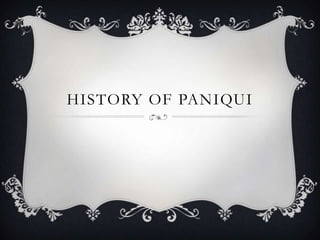
History of paniqui (2)
- 2. PRE-SPANISH SETTLEMENTS IN PANGASINAN AND PAMPANGA Before the arrival of the Spaniards led by Magellan in the Philippines there where already settlements along the coasts, bays and rivers in the country. The Pangasinense settlements were called sitios.
- 3. TRADE ROUTES There were already trade relations between the people from the north with the people from the south during the Spanish Era The trading was originally made via the South China Sea until the Pangasinenses expanded their territories to the south discovering the Agno River which gave birth to the Agno-Pampanga River System.
- 4. EARLY SETTLEMENT IN PANIQUI The accessibility of the people from the north to the people from the south via this trade route encouraged more Pangasinenses and Ilocanos to settle along the Agno river system and the Pampangos and the Tagalogs to settle along the Pampanga river system. This gave rise to the Pampanga, Candaba and Arayat settlements. This river trade route gave birth to the sitio of “Manggang Marikit”
- 5. THE LEGEND OF MANGGANG MARIKIT “Manggang Marikit” was a beautiful maiden who was hung by her two suitors in a mango tree located at the heart of the locality because of her fickle mindedness to choose who between her two suitors shall be her husband. Unknown to each of the suitors she had answered them both positively. Thus, realizing what the lady had done, both suitors got angry. As a reprisal they agreed to hang her in a mango tree within the plaza of the sitio.
- 6. OTHER SETTLEMENTS ALONG THE AGNO RIVER SYSTEM Binalatongan – now SAN CARLOS CITY Manaoag Bagnotan – now DAGUPAN Ling-ngayen – now LINGAYEN Urbiztondo Malunguey – now BAYAMBANG Talbang – now BAUTISTA
- 7. THE RE NAMING OF SITIO DE MANGGANG MARIK IT TO PAMPANNIK I AND FINAL LY TO PANIQUI In a short span of time, the Ilocano-speaking settlers increased in number to the extent that they had popularized the name of the sitio into Pampanikki because of the presence of numerous fruit bats in the area, thus Manggang Marikit became popularly known as Pampanniki. It was from these fruit bats where the present name of Paniqui was derived.
- 8. When Spaniards came to the sitio, they can hardly pronounce Pampanikki. Hence they shortened the name into sitio de Paniqui. The spelling of the name Paniqui was again changed to Paniki during the Quezon Commonwealth Government because of the compliance with the Filipinonization of the names of places in the Philippines, its spelling was reverted from Paniki to Paniqui because the latter was preferred by the people.
- 9. SPANISH EXPLORATION Don Martin de Goiti – 1571 Don Juan Salcedo – 1574
- 10. THE DOMINICAN ORDER MISSION IN SITIO PANIQUI BEFORE 1686 The acceptance of the Visita de Sta. Rosa de Lima of Sitio de Paniqui by the Dominican Order in 1686. Visita – A chapel in the community where services were conducted by a visiting padre because the number of people served were few to merit its own priest Sta. Rosa de Lima was its own patroness and entrusted it to the care if the Vicaria de Telbang (now Bautista, Pangasinan) padre Gregorio Ecchevarria, OP.
- 11. THE FORMAL E STABL ISHME NT OF SITIO DE PANIQUI INTO PUE BL O DE PANIQUI In 1712 two brothers Raymundo and Manuel Paragas was sent by the Provincial Government of Pangasinan to spread the Christian faith and to form a local government unit. The whole of Manggang Marikit was claimed by the brothers. Raymundo Paragas became the first head if the Pueblo de Paniqui
- 12. SITIOS BELONGING TO THE ESTABLISHED PUEBLO DE PANIQUI Visita de San Isidro – now CUYAPO Visita de Barog – now GERONA Visita de San Jose de Camiling – now CAMILING
- 13. PUEBLO DE PANIQUI BECAME A PARROQUIA IN 1718 As Don Raymundo and Manuel Paragas encouraged more and more settlers to embrace the Christian Faith, the Pueblo de Paniqui was made into a parroquia on May 4, 1718 with Sta. Rosa de Lima as its patroness. Its first Cura Parocco (parish priest) was Padre Jose Sanchez OP Visita de Paniqui was made into a Parroquia and at the same time elevated into a Vicaria de Sta. Rosa de Lima in 1718.
- 14. The town of paniqui from its original location along the Agno- Pampanga river system was moved several times to different sites during the Spanish period.
- 15. 1720 – Pueblo de Paniqui was transferred from the west of the Tarlac River to Nagmisaan site. The place was named Nagmisaan because the evacuuees from the Pueblo de Paniqui held their first Mass in the area.
- 16. REASONS OF TRANSFER Negritos constantly attacked the pueblo. The revolt made by Juan Caragay, a church servant of Dagupan against the Spaniards in 1719.
- 17. 1721 – Pueblo de Paniqui transferred from nagmisaan to Acocolao The place was called Acocolao because the old women (acocolao) were usually left behind by their husbands who worked outside the area.
- 18. Paniqui was a fluorishing town at that time, it consists around 76 barangays. The larger of these barangays were: “Bani” now RAMOS, “San Ramon” now MONCADA, “San Jose de Anao now ANAO, “De Villa” now PURA, “Binaca” now STA. IGNACIA During this time, it was the first town of Pangasinan where Sultan Alimuddin I of Jolo was baptized and his son, Israel and daughter, Fatima were converted to Christianity.
- 19. 1804 – Pueblo de Paniqui transferred to Pugong Cadanglaan site Pugong Cadanglaan is a place where the dangla plants (Lagundi) thrived in abundance.
- 20. It was in Pugong Cadanglaan where the church, convent, town hall and market were located. The earliest building of the church and convent was reported by Padre Manuel Mora, OP in 1804. From then on, the town of Paniqui was never transferred.